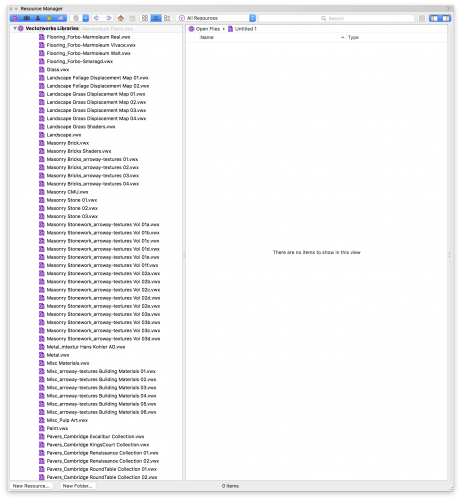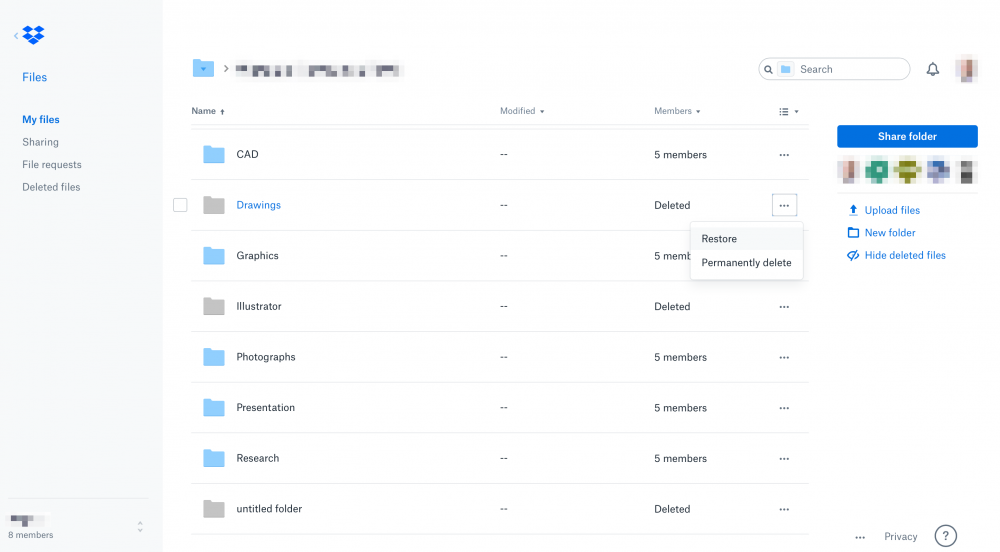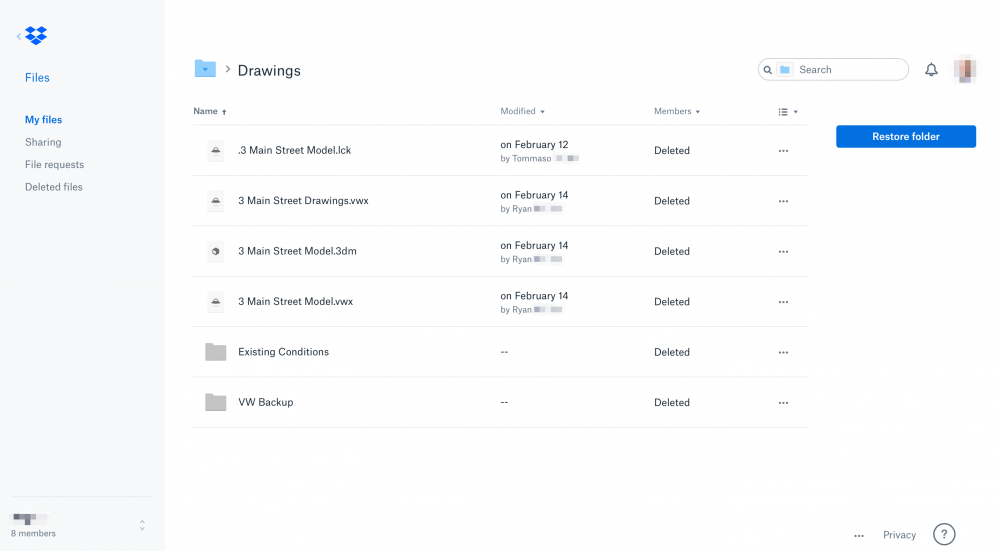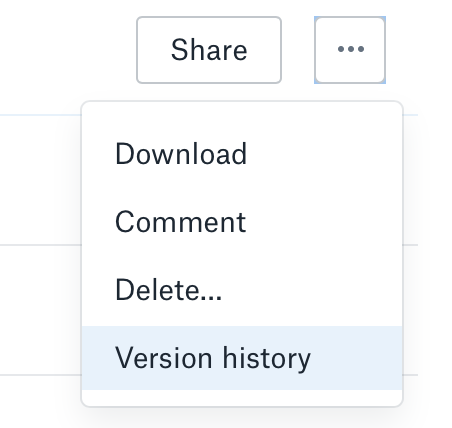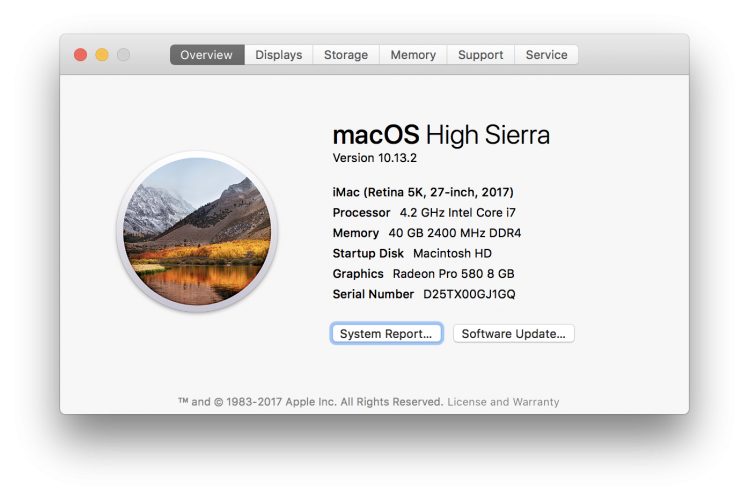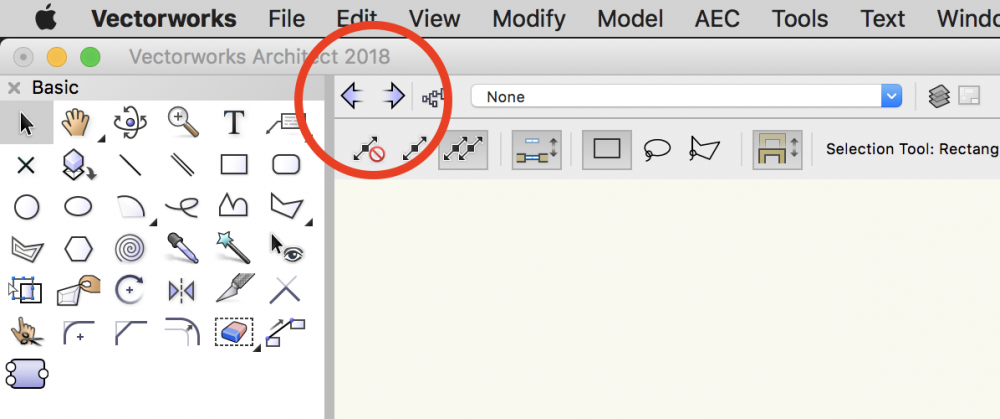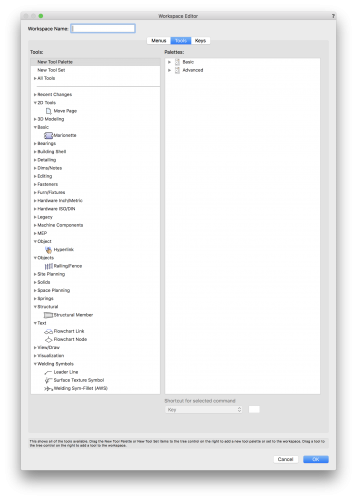
ThreeDot
Member-
Posts
167 -
Joined
-
Last visited
Content Type
Profiles
Forums
Events
Articles
Marionette
Store
Everything posted by ThreeDot
-
Users can certainly choose to use underscores for naming files, classes, or whatever, but the built-in resource library should be organized, labeled, and tagged in a manner that conforms to (a) UX/UI best practice and (b) proper language standards. There is no technical limit on naming resources correctly. Capitalization, abbreviation, punctuation, and grammar matter in life and in software. Underscores have no place in the user interface. The current Vectorworks resource library is a mishmash of poorly named, poorly organized files. It looks like files were received from third-party vendors and dropped into the resource folder without much attention to organization or naming. Why does this matter? Inconsistent organization makes it difficult to browse for resources quickly. Incorrect spelling makes it difficult to search resources accurately. Incorrect grammar is sloppy and unprofessional, in any setting. As with anything in life, lack of care on small stuff signifies lack of care on big stuff. Vectorworks needs to improve the resource library. Not just the files that reside in the library, but the procedure for how files are added and maintained over time. Maintaining a good library has always been important, but even more so now that users increasingly rely on accurate 2D, 3D, and BIM components. New resources should be added on a regular basis, and outdated resources should be removed. Resources should be organized, named, and tagged properly. Resources should be audited regularly to ensure that they adhere to current Vectorworks standards and best practices, meaning that old resources may need to be updated as Vectorworks evolves. A clear and flexible organizational structure should be established up front, so that resources can be properly organized and maintained over time. “Misc” is not a category. You get the idea.
-
Yeah, totally! Being able to pull up any drawing, specification, or correspondence on site has saved us sooooo much time. I wish that Vectorworks' connection to Dropbox was more convenient. Or maybe I just don't understand how Vectorworks Cloud Services is supposed to work. Perhaps you can help. We keep all project files, including Vectorworks files, in a Dropbox folder. Simple. I like that Vectorworks Cloud Services can generate models and render viewports on demand or on a pre-set schedule, but it seems that Vectorworks files have to live in the VCS folder. I don't want to duplicate Vectorworks files into a VCS folder, nor do I want to relocate active project files outside of the Dropbox project folder. I guess I don't understand how the Vectorworks-Dropbox integration is supposed to work. Our initial tests were frustrating and I didn't see a way to work without disrupting project folder integration. Do you use Vectorworks Cloud Services? How does that work (or not) with your new Dropbox workflow?
-
That's great! I had to look up what you meant about online-only versus local folders. That is an early access feature that I didn't know about. It looks interesting. iCloud sync works like that. This will be great for my MacBook! We've had pretty much the same Dropbox procedure since the beginning. All files are synced to my work iMac, which is where I do most of my work and where I have redundant local and remote backups running constantly. I selectively sync files to my MacBook—for working at home or on the train—and we share folders as needed with staff and consultants. We've structured our file system to allow for sharing and syncing on a folder-by-folder basis. There is a standard set of folders that everyone gets access to automatically (e.g. reference library), but specific files are shared on an individual basis. Project proposals and agreement folders are shared with our attorney. Business and financial folders are shared with our bookkeeper and accountant. Branding and website folders are shared with our graphic designers and in-house design staff. Project files are shared with project architects. And so on. In that way, everyone has all relevant files synced locally to their own machine(s).
-
Dropbox does make a call to the cloud before starting a LAN sync. We've had fast, reliable connections over the past ten years and rarely run into problems. With general, non-Vectorworks file sharing, temporary outages have not caused any problems. We've only recently started using Vectorworks Project Sharing. We've had the internet drop out once or twice while users had objects and layers checked out. We continued working as usual and committed changes when service was restored. It did not cause any problems for us. We've had a few problems with Vectorworks Project Sharing that are not related to Dropbox. Vectorworks support recommended, in general, that we check out layers and sheets rather than individual objects. It seems that reducing the check-out and check-in cross traffic is recommended whether using a local server or Dropbox. I would really, really love for Vectorworks to introduce more reliable, more granular commits. Does ArchiCAD do this, or do I have grass-is-greener syndrome?
-
I suppose the cost of a Mac Mini versus Dropbox licenses is roughly equal, but we’ve found: A. IT costs over time are much lower. Zero time is spent on hardware or software upgrades related to a server. We have to maintain local machines an our network, but that is very light. In fact we rarely need any IT for our office. B. Staff efficiency is much better. All “server” files are local. There is zero delay tabbing through folders and files can be previewed at the flick of a finger. Files and folders can be shared, individually or en masse, very easily. It’s nice to be able to drop a shared link into an email and not worry about file size. Or, to provide a contractor with persistent shared access to a folder with drawings, SKs, or cutsheets. Or, for staff to access any file, at any computer, phone, or tablet, at any project site, or long train commute, at any time without having to “remote in”. Ack! The value of all of that is priceless. I recently jumped in with a partner firm to help out with a deadline. They are running a Mac Mini server with SSD drives on a gigabit network. I was shocked at how slow everything moved. Every click, delay. Every photo preview, delay. Every folder move and rename, delay. Maybe they are set up wrong, but I would not last a day in that environment.
-
Yeah, agreed. Dropbox is so flexible, secure, and reliable that there are very few arguments for running a local server. We work in a shared office with several similar-sized architectural and design firms. The firms running local servers often run into problems and limitation that require IT intervention and awkward workarounds. Our team must stay organize and communicate about who is working on what, but that is how a well-oiled team is supposed to run. In a funny way, we've found that Dropbox's limitations actually reinforce better structure and communication within our office.
-
We may be on a grandfathered plan, or I may have misremembered. I believe that our plan is roughly equivalent to Dropbox Business Advanced. See here: https://www.dropbox.com/business/plans-comparison
-
Oh, yes! This is a ball of yarn with Vectorworks. Can we clean up Design Layers and Sheet Layers? Classes, layers, stories, sheets, viewports, and references are perfectly clear. Can we consolidate three locations on the drawing screen for classes, layers, and sheets? Can we eliminate A/B naming? Top/Plan should be Plan. Dims/Notes should be Annotation. Can we eliminate random abbreviations? Furn should be Furniture. Building Equip_Appliances is awkwardly long, while Ent Stage, which is in the same list, is awkwardly short. Can we eliminate the underscore? This isn't a DOS. Can we consolidate imperial and metric tools?
-
We do pretty much the same thing. We rely on Dropbox for file recovery, but we have redundant local Time Machine backups running hourly and remote Crashplan backups running every fifteen minutes. We have not yet had to recover files from Time Machine or Crashplan because Dropbox has been so reliable. Deleted files are hidden by default in Dropbox, but you can show them, browse, and recover files as needed. You can also recover or revert to incremental versions of any file, which is really amazing.
-
When a local file is created, edited, or deleted, those changes are synced to the cloud then synced to client machines at the earliest opportunity. In most cases, that sync is nearly instantaneous. In other cases, the sync is queued until a computer has an internet connection. Computers on the same LAN are synced directly without an initial call to the cloud. We run a Dropbox business account that has unlimited backups. If a file is accidentally deleted by another user, it can be recovered easily via the web app. In day-to-day use, this is rarely a problem. It's essential to have a clear folder structure and file naming scheme, to communicate regularly about who is working on what, to make everyone responsible for keeping files tidy, and to close and sync files before walking away. We've implemented those basic rules and have run on Dropbox without any problems since 2010.
-
We use project sharing with Dropbox. Typically, only two people are shared on a project file. We are careful to commit changes: not too often and not simultaneously. We've had trouble when a user opens a file or commits changes before Dropbox has synced all files. For example, an employee opened a working file at home and committed changes before his internet connection could sync files. We did not get a "conflicted copy" error in Dropbox, but the link between the working file and project file was broken and we had to go through a tedious process of creating a new working file and manually copy and paste everything from the corrupted working file to the new working file. We continue to use project sharing with Dropbox, but we really have to tip-toe around this limitation. We are a small office and, like a lot of small offices, we abandoned our local server long ago and use Dropbox instead. Vectorworks (including Cloud Services) needs to play better with Dropbox.
-
This happens to me regularly since upgrading to 2018. I have not found a reliable way to reproduce or correct it. Changing graphics from Best Compatibility to Best Performance to seems to help, but then it doesn't. It happens most often with groups and compound objects, like dimensions. Sometimes clicking into a ghosted group, then exiting the group, will solve the problem.
-
Delta Save & Commits
ThreeDot replied to Christiaan's question in Wishlist - Feature and Content Requests
Yes! We have to tip toe around this constantly. -
That's not naïve! I am running a top end 2017 iMac and Vectorworks frequently has trouble displaying 2D objects in plan view. Geometry will constantly blank out during simple pan and zoom operations. I submitted a video to tech support last week (see attached). This was such an obvious problem when I started running VW2018 that I assumed it would be reported and corrected with SP1. That didn't happen with SP1, or SP2, so I finally submitted a help request last week. I can say that all other software (Cinema4D, SketchUp, Illustrator, Pixelmator, Sketch, etc.) runs perfectly fast and smooth on this computer. In fact, all software runs perfectly fine on my old 2013 iMac. Vectorworks is the only application that runs so poorly. It's leagues worse than anything else and it's embarrassingly bad. Screen Redraw Problem (2018-01-05).mov
-
I've had this same problem on a 2017 iMac. Some days Vectorworks is unusable, with huge portions of the screen flickering on and off and I scroll and pan around a drawing. Setting the display preferences to "Best Compatibility" helps, but does not solve the problem. I'm running modern hardware and Vectorworks is a mess. I'll try to record a video and submit to tech support, but I frankly don't have time to troubleshoot basic functionality. Didn't the graphics pipeline just get completely revamped? Why is this a problem?
-
That's not the same. Those settings work for Top/Plan view only. When working in a 3D view, I prefer to work in perspective. When working in a top, bottom, front, back, or side view, I prefer to work in an orthographic projection. I rarely want perspective when editing an elevation. What Blender does is much smarter. In Vectorworks, if Perspective mode is set, then: In Vectorworks, if Orthographic mode is set, then: In Blender, if Auto Perspective mode is set, then: P.S. Can someone explain why the "Top/Plan" view (Top slash Plan) can't simply be called "Plan"? I've never understood why we need the "Top/" part of that label. Isn't a plan always an orthographic top projection? Or at least enough that it can be safely be labeled "Plan" to simplify the interface. Wouldn't that also negate the need for the preferences, settings, and UI elements that markdd mentioned. Plan would always be a orthographic wireframe projection and Top would be used to create perspective and rendered plans.
-
I've never used Blender, but I recently stumbled upon a Blender feature called Auto Perspective. When this option is turned on, Blender will automatically snap to an orthographic projection for top, bottom, front, back, and side views and return to a perspective projection for 3D views. I spend way too much time switching between orthographic and perspective views and I would love to see this feature in Vectorworks. Video 1: Video 2:
-
View History in View Bar
ThreeDot replied to ThreeDot's question in Wishlist - Feature and Content Requests
I disagree. That would be too tedious and ambiguous. If I'm jumping, I don't want to jump to the third zoom twice removed from my sister's uncle. It's better to simply leap backward to the last known view on a particular sheet or design layer. Keep the current functionality to click, click, step, step through individual view changes, but give users an option to leap to the lats known view on a previous layer. For example: Exterior Details (Design Layer) Plan Details (Design Layer) A-100 Site Plan (Sheet Layer) Interior Elevations (Design Layer) -
View History in View Bar
ThreeDot replied to ThreeDot's question in Wishlist - Feature and Content Requests
That setting has no effect on the navigating forward or backward through views. I'm not suggesting changes to the Undo command, just to view navigation. Here is a common scenario: I'm working on a detail on a design layer. I want to check a dimension on another design layer, so I click that layer, pan and zoom to find what I need, check a dimension, then jump back to my original design layer. Currently, I might click, zoom, and pan five or ten times to get that dimension, then have to back up through all five or ten view steps to get back to my original design layer. A single jump back to the original design layer would be incredibly useful. -
View History in View Bar
ThreeDot replied to ThreeDot's question in Wishlist - Feature and Content Requests
It needs to jump back through layers, sheets, and views to be useful. The current functionality is to click step by step backward (or forward) through view changes. This includes every zoom, pan, orbit, and navigation between design layers and sheet layers and can be really tedious. I would love to click and hold to display a menu, similar to a browser, that will jump back to a previous design layer or sheet layer without stepping through all the tedious zooms, pans, and orbits. This would all users to jump between layers, sheets, and views more quickly while still retaining current functionality. -
I use the Previous View and Next View buttons occasionally, but they would be more useful if I could quickly jump backward or forward multiple views. Most modern browsers have implemented a press-and-hold back button to view recent browsing history. Here is an example from Chrome.
-
Revamping the Vectorworks interface may be a long-term project, but in the short term, it would be helpful if the menu and tool lists in the Workspace Editor weren't so disorganized. The tool list, in particular, seems totally random and disorganized. Why is Move Page the only item under 2D Tools? Why is Marionette, and advanced tool, the only item under Basic? Why are their separate categories for Object and Objects, each containing one arbitrary item? Why is Leader Line, one of the primary annotation tools for most users, hidden under Welding Symbols? On the positive side, I really like the relatively new "Recent Changes" category, but it would be nice if new tools and depreciated tools were listed by version. I've been a Vectorworks user since MiniCAD, and I can sort of see how shifting paradigms over the years have lead to an unstructured list. Providing order to this list might begin to provide structure to the how tools are organized in the workspace.
-
Yeah, totally. I've had this conversation with many people over the years. We have a Dropbox Business account, which costs about $800 per year for five users, 5TB of storage, unlimited history, granular control over users and security, priority tech support, et cetera. It's a drop in the hat for a service that is more critical than our physical office. We've had zero problems over the years and have not spent a single dollar on server hardware or support. We issue Dropbox licenses to long-term consultants who require frequent access to shared project files. Users can simultaneously have Dropbox Business and Dropbox Personal accounts on the same machine while keeping each account completely separate from each other. We cover the cost of their Dropbox license, but that cost is negligible given the gain in efficiency. When the project is over, we give notice and revoke the license, which automatically removes files from their machine and frees up licenses for others. We do the same for summer interns, who are shared on a broad range of project and resource folders and are not asked to pay out of pocket to accommodate our huge folder sizes. Similarly, we dropped Microsoft Office years ago. We use Google Docs and Sheets for all internal and external collaborative work. We run a Mac-based office and use Pages to format good-looking proposals and invoices our letterhead. Not only did we shed Microsoft expenses, but we also got much better at co-authoring and real-time collaboration.
-
You don't like clicking a 20 x 8 pixel button, then choosing an option from the fly-out menu!? I'm embarrassed to say that I've been annoyed by that tiny button for years, but have never done anything about it.
-
We've been using Dropbox for more than 10 years to sync everything in our office. We have hundreds of files syncing on any given day and we have several terabytes stored in the cloud. We've scaled from two employees, to dozens, and back again, without any trouble. It's really easy sync select folders to specific people and devices, or to share select folders with outside consultants. We eliminated our local server ten years ago and run our business(s) entirely on Dropbox and Google Apps. I love being able to access any file, from any device, anywhere in the world. Team communication and file naming standards are really, really important. Files are not checked out or locked when in use, so we are very rigorous about (a) communicating with each other about who is working on what (we use Slack, Hangouts, and verbal communication) and (b) using clear, consistent file naming. Work is never lost, but you can get "conflicted copy" duplicates if multiple people work on the same file. Our technology sister company has consulted many clients about workflow efficiency, which relates to people, technology, and standards. Google Apps are amazing for email, calendaring, contacts, and document collaboration, but Google Drive is not a reliable file repository. Every company I know—from single person boutiques to massive enterprise organizations—have regretted using Google Drive to store and sync files. Go with Dropbox.

